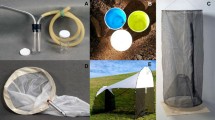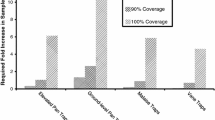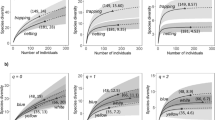Abstract
Agri-environment schemes have been implemented across the European Union in order to reverse declines in farmland biodiversity. To assess the impact of these schemes for bumblebees, accurate measures of their populations are required. Here, we compared bumblebee population estimates on 16 farms using three commonly used techniques: standardised line transects, coloured pan traps and molecular estimates of nest abundance. There was no significant correlation between the estimates obtained by the three techniques, suggesting that each technique captured a different aspect of local bumblebee population size and distribution in the landscape. Bumblebee abundance as observed on the transects was positively influenced by the number of flowers present on the transect. The number of bumblebees caught in pan traps was positively influenced by the density of flowers surrounding the trapping location and negatively influenced by wider landscape heterogeneity. Molecular estimates of the number of nests of Bombus terrestris and B. hortorum were positively associated with the proportion of the landscape covered in oilseed rape and field beans. Both direct survey techniques are strongly affected by floral abundance immediately around the survey site, potentially leading to misleading results if attempting to infer overall abundance in an area or on a farm. In contrast, whilst the molecular method suffers from an inability to detect sister pairs at low sample sizes, it appears to be unaffected by the abundance of forage and thus is the preferred survey technique.



Similar content being viewed by others
References
Baum KA, Wallen KE (2011) Potential bias in pan trapping as a function of floral abundance. J Kansas Entomol Soc 84:155–159
Benton TG, Vickery JA, Wilson JD (2003) Farmland biodiversity: is habitat heterogeneity the key? Trends Ecol Evol 18:182–188
Biesmeijer JC, Roberts SPM, Reemer M, Ohlemuller R, Edwards M, Peeters T, Schaffers AP, Potts SG, Kleukers R, Thomas CD, Settele J, Kunin WE (2006) Parallel declines in pollinators and insect pollinated plants in Britain and the Netherlands. Science 313:351–354
Brittain C, Williams N, Kremen C, Klein A-M (2013) Synergistic effects of non-Apis bees and honey bees for pollination services. Proc R Soc Lond B 280:1–7
Cane JH, Minckley RL, Kervin LJ (2000) Sampling bees (Hymenoptera: Apiformes) for pollinator community studies: pitfalls of pan-trapping. J Kansas Entomol Soc 73:225–231
Carvell C, Roy DB, Smart SM, Pywell RF, Preston CD, Goulson D (2006) Declines in forage availability for bumblebees at a national scale. Biol Conserv 132:481–489
Carvell C, Meek WR, Pywell RF, Goulson D, Nowakowski N (2007) Comparing the efficacy of agri-environment schemes to enhance bumblebee abundance and diversity on arable field margins. J Appl Ecol 44:29–40
Carvell C, Osborne JL, Bourke AFG, Freeman SN, Pywell RF, Heard MS (2011) Bumble bee species responses to a targeted conservation measure depend on landscape context and habitat quality. Ecol Appl 21:1760–1771
Dornhaus A, Chittka L (1999) Evolutionary origins of bee dances. Nature 401:38
Estoup A, Scholl A, Pouvreau A, Solignac M (1995) Monandry and polyandry in bumble bees (Hymenoptera; Bombinae) as evidenced by highly variable microsatellites. Mol Ecol 4:89–93
Estoup A, Solignac M, Cornuet M, Goudet J, Scholl A (1996) Genetic differentiation of continental and island populations of Bombus terrestris (Hymenoptera: Apidae) in Europe. Mol Ecol 5:19–31
Fuentes-Montemayor E, Goulson D, Cavin L, Wallace JM, Park KJ (2012) Factors influencing moth assemblages in woodland fragments on farmland: implications for woodland management and creation schemes. Biol Conserv 153:265–275
Garibaldi LA, Steffan-Dewenter I, Kremen C et al (2011) Stability of pollinator services decreases with isolation from natural areas despite honey bee visits. Ecol Lett 14:1062–1072
Garibaldi LA, Steffan-Dewenter I, Winfree R et al (2013) Wild pollinators enhance fruit set regardless of honey bee abundance. Science 339:1608–1611
Goulson D (2010) Bumblebees: Behaviour, Ecology and Conservation, 2nd edn. Oxford University Press, Oxford
Goulson D, Hughes WOH, Derwent LC, Stout JC (2002) Colony growth of the bumblebee, Bombus terrestris, in improved and conventional agricultural and suburban habitats. Oecologia 130:267–273
Goulson D, Hanley ME, Darvill B, Ellis JS, Knight ME (2005) Causes of rarity in bumblebees. Biol Conserv 122:1–8
Goulson D, Lepais O, O’Connor S, Osborne JL, Sanderson RA, Cussans J, Goffe L, Darvill B (2010) Effects of land use at a landscape scale on bumblebee nest density and survival. J Appl Ecol 47:1207–1215
Grixti JC, Wong LT, Cameron SA, Favret C (2009) Decline of bumble bees (Bombus) in the North American Midwest. Biol Conserv 142:75–84
Heard MS, Carvell C, Carreck NL, Rothery P, Osborne JL, Bourke AFG (2007) Landscape context not patch size determines bumble-bee density on flower mixtures sown for agri-environment schemes. Biol Lett 3:638–641
Herrmann F, Westphal C, Moritz RFA, Steffan-Dewenter I (2007) Genetic diversity and mass resources promote colony size and forager densities of a social bee (Bombus pascuorum) in agricultural landscapes. Mol Ecol 16:1167–1178
Holehouse KA, Hammond RL, Bourke AFG (2003) Non-lethal sampling of DNA from bumble bees for conservation genetics. Insectes Soc 50:277–285
Jones O, Wang J (2009) COLONY: a program for parentage and sibship inference from multilocus genotype data. Mol Ecol Resour 10:551–555
Kells AR, Goulson D (2003) Preferred nesting sites of bumblebee queens (Hymenoptera: Apidae) in agroecosystems in the UK. Biol Conserv 109:165–174
Kleijn D, Sutherland WJ (2003) How effective are European agri-environment schemes in conserving and promoting biodiversity? J Appl Ecol 40:947–969
Kleijn D, Baquero RA, Clough Y et al (2006) Mixed biodiversity benefits of agri-environment schemes in five European countries. Ecol Lett 9:243–254
Klein A-M, Steffan-Dewenter I, Tscharntke T (2003) Fruit set of highland coffee increases with the diversity of pollinating bees. Proc R Soc Lond B 270:955–961
Klein A-M, Vaissiere BE, Cane JH, Steffan-Dewenter I, Cunningham S, Kremen C, Tscharntke T (2007) Importance of pollinators in changing landscape for world crops. Proc R Soc Lond B 274:303–313
Knight ME, Martin AP, Bishop S, Osborne JL, Hale RJ, Sanderson RA, Goulson D (2005) An interspecific comparison of foraging range and nest density of four bumblebee (Bombus) species. Mol Ecol 14:1811–1820
Kosior A, Celary W, Olejniczak P, Fijal J, Krol W, Solarz W, Plonka P (2007) The decline of the bumble bees and cuckoo bees (Hymenoptera: Apidae: Bombini) of Western and Central Europe. Oryx 41:79–88
Leong JM, Thorp RW (1999) Colour-coded sampling: the pan trap colour preferences of oligolectic and non-oligolectic bees associated with a vernal pool plant. Ecol Entomol 24:329–335
Lepais O, Darvill B, O’Connor S, Osborne JL, Sanderson RA, Cussans J, Goffe L, Goulson D (2010) Estimation of bumblebee queen dispersal distances using sibship reconstruction method. Mol Ecol 19:819–831
Miller CR, Joyce P, Waits LP (2005) A new method for estimating the size of small populations from genetic mark–recapture data. Mol Ecol 14:1991–2005
Morandin LA, Kremen C (2013) Hedgerow restoration promotes pollinator populations and exports native bees to adjacent fields. Ecol Appl 23:829–839
Natural Research Council (2006) Status of pollinators in north america, National Academies Press, Washington, D.C.
O’Connor S, Park KJ, Goulson D (2012) Humans versus dogs: a comparison of methods for the detection of bumblebee nests. J Apic Res 51:204–211
Osborne JL, Williams IH (1996) Bumblebees as pollinators of crops and wild flowers. In: Matheson A (ed) Bumblebees for pleasure and profit. IBRA, Cardiff, pp 24–32
Osborne JL, Clark SJ, Morris RJ, Williams IH, Riley JR, Smith AD, Reynolds DR, Edwards AS (1999) A landscape- scale study of bumble bee foraging range and constancy, using harmonic radar. J Appl Ecol 36:519–533
Osborne JL, Martin AP, Shortall CR, Todd AD, Goulson D, Knight ME, Hale RJ, Sanderson RA (2008) Quantifying and comparing bumblebee nest densities in gardens and countryside habitats. J Appl Ecol 45:784–792
Pollard E, Yates TJ (1993) Monitoring butterflies for ecology and conservation. Chapman and Hall, London
Potts SG, Biesmeijer JC, Kremen C, Neumann P, Schweiger O, Kunin WE (2010) Global pollinator declines: trends, impacts and drivers. Trends Ecol Evol 25:345–353
Pywell RF, Warman EA, Hulmes L, Hulmes S, Nuttall P, Sparks TH, Critchley CNR, Sherwood A (2006) Effectiveness of new agri-environment schemes in providing foraging resources for bumblebees in intensively farmed landscapes. Biol Conserv 129:192–206
Roulston TH, Smith SA, Brewster AL (2007) A comparison of pan trap and intensive net sampling techniques for documenting a bee (Hymenoptera) fauna. J Kansas Entomol Soc 80:179–181
Scheper J, Holzschuh A, Kuussaari M, Potts SG, Rundlöf M, Smith HG, Kleijn D (2013) Environmental factors driving the effectiveness of European agri-environment measures in mitigating pollinator loss—a meta-analysis. Ecol Lett 16:912–920
Schmid-Hempel R, Schmid-Hempel P (2000) Mating frequencies in Bombus spp. from Central Europe. Insectes Soc 47:36–41
Steffan-Dewenter I, Munzenberg U, Burger C, Thies C, Tscharntke T (2002) Scale-dependent effects of landscape context on three pollinator guilds. Ecology 83:1421–1432
Stephen WP, Rao S (2005) Unscented color traps for non-Apis bees (Hymenoptera: Apiformes). J Kansas Entomol Soc 78:373–380
Sunderland KD, De Snoo GR, Dinter A, Hance T, Helenius J, Jepson P, Kromp B, Samu F, Sotherton NW, Ulber B, Vangsgaard C (1995) Density estimation for invertebrate predators in agroecosystems. Acta Jutland 70:133–164
Toler TR, Evans EW, Tepedino VJ (2005) Pan- trapping for bees (Hymenoptera: Apiformes) in Utah’s west desert: the importance of color diversity. Pan-Pac Entomol 81:103–113
Truett GE, Heeger P, Mynatt RL, Truett AA, Walker JA, Warman ML (2000) Preparation of PCR-quality mouse genomic DNA with hot sodium hydroxide and tris (HotSHOT). Biotechniques 29:52–54
Tscharntke T, Gathmann A, Steffan-Dewenter I (1998) Bioindication using trap-nesting bees and wasps and their natural enemies: community structure and interactions. J Appl Ecol 35:708–719
Walther-Hellwig K, Frankl R (2000) Foraging distances of Bombus muscorum, Bombus lapidarius and Bombus terrestris (Hymenoptera, Apidae). J Insect Behav 13:239–246
Westphal C, Steffan-Dewenter I, Tscharntke T (2003) Mass flowering crops enhance pollinator densities at a landscape scale. Ecol Lett 6:961–965
Westphal C, Steffan-Dewenter I, Tscharntke T (2006) Bumblebees experience landscapes at different spatial scales: possible implications for coexistence. Oecologica 149:289–300
Westphal C, Bommarco R, Carre G et al (2008) Measuring bee diversity in different European habitats and biogeographical regions. Ecol Monogr 78:653–671
Williams PH, Osborne JL (2009) Bumblebee vulnerability and conservation worldwide. Apidologie 40:367–387
Williams PH et al (2005) Does specialization explain rarity and decline among British bumblebees? A response to Goulson. Biol Conserv 122:33–43
Williams NM, Regetz J, Kremen C (2012) Landscape-scale resources promote colony growth but not reproductive performance of bumble bees. Ecology 93:1049–1058
Winfree R, Williams NM, Duschoff J, Kremen C (2007) Native bees provide insurance against ongoing honeybee losses. Ecol Lett 10:1105–1113
Acknowledgments
We would like to thank all farmers for access to their land during the survey and the two reviewers who provided many helpful comments. This research was funded by the Natural Environment Research Council grant NE/J016802/1 and the Game & Wildlife Conservation Trust.
Conflict of intrest
The authors declare that they have no conflict of interest.
Author information
Authors and Affiliations
Corresponding author
Additional information
Communicated by Ingolf Steffan-Dewenter.
Rights and permissions
About this article
Cite this article
Wood, T.J., Holland, J.M. & Goulson, D. A comparison of techniques for assessing farmland bumblebee populations. Oecologia 177, 1093–1102 (2015). https://doi.org/10.1007/s00442-015-3255-0
Received:
Accepted:
Published:
Issue Date:
DOI: https://doi.org/10.1007/s00442-015-3255-0




